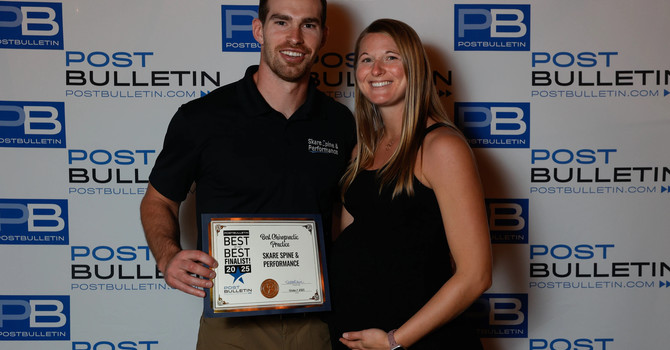
Shoulder blade pain, also known as scapular pain, can be a real pain in the neck—or, more accurately, in the upper back!
This nagging ache, sharp twinge, or persistent discomfort can limit your range of motion, disrupt your sleep, and interfere with everyday activities. Shoulder blade pain can persist, no matter how much stretching, foam rolling, and massages you seem to do.
At Skare Spine & Performance in Rochester, MN, we understand the frustration shoulder blade pain can cause. We're here to help you understand its causes and provide effective solutions for relief.
What Causes Shoulder Blade Pain?
Shoulder blade pain is rarely caused by a problem with the shoulder blade itself. Instead, it often stems from issues in the surrounding muscles, joints, nerves, or even referred pain from other areas.
Here are some common culprits:
1. Muscle Strain or Overuse:
The muscles surrounding your shoulder blade, including the trapezius, rhomboids, and levator scapulae, can become strained or overworked due to:
- Poor posture: Slouching or hunching over can put excessive stress on these muscles.
- Repetitive motions: Activities like typing, painting, or playing sports can strain the muscles around the shoulder blade.
- Heavy lifting: Lifting heavy objects without proper form can cause muscle strain.
- Trigger points: These tight, knotted areas within muscles can refer pain to the shoulder blade and limit movement.
2. Joint Dysfunction:
Problems with the joints in your neck, upper back, or shoulder can also contribute to shoulder blade pain. This can include:
- Cervical spine dysfunction: Stiffness and joint restrictions in your neck can affect the nerves and muscles that control your shoulder blade.
- Thoracic spine dysfunction: Restricted movement in your upper back can alter shoulder blade mechanics and cause pain.
- Shoulder joint problems: Conditions like rotator cuff injuries or frozen shoulder can refer pain to the shoulder blade.
3. Nerve Irritation:
Nerves originating in your neck can become compressed or irritated, leading to pain radiating to your shoulder blade. This can be caused by:
- Herniated discs: A bulging disc in your neck can press on a nerve root.
- Cervical stenosis: Narrowing of the spinal canal in your neck can compress nerves.
- Thoracic outlet syndrome: Compression of nerves and blood vessels in the space between your collarbone and first rib.
4. Referred Pain:
Sometimes, shoulder blade pain can be a symptom of a problem elsewhere in your body. For example:
- Heart conditions: In rare cases, shoulder blade pain can be a sign of a heart attack, especially in the left shoulder blade.
- Gallbladder problems: Gallbladder disease can sometimes refer pain to the right shoulder blade.
- Lung conditions: Diseases affecting the lungs or pleura (lining of the lungs) can also cause shoulder blade pain.
5. The Cloward Sign:
This specific type of shoulder blade pain is characterized by a deep, aching pain in the angle of the shoulder blade. This type of shoulder blade pain doesn’t subside no matter how much stretching or soft tissue release you do of the muscles around the scapulae. It's often associated with dysfunction in the lower neck (C5-C7 vertebrae) and can be effectively treated with chiropractic care.
How to Relieve Shoulder Blade Pain: A Multifaceted Approach
At Skare Spine & Performance, we understand that shoulder blade pain can be complex, with multiple contributing factors. That's why we take a comprehensive approach to diagnosis and treatment.
Self-Treatment Options for Shoulder Blade Pain:
Before you come to us, you can try these self-care options at home. If your pain persists for more than a few days, please schedule an appointment with us.
- Foam Rolling: Foam rolling can help mobilize the joints in the upper and mid-back. Stiff joints, especially from poor posture, can often contribute to shoulder blade pain.
- Chin Retractions: Chin retractions can help mobilize joints in the lower neck. Shoulder blade pain is often a referred pain from the neck. Perform ten chin retractions every 1-2 hours over the course of a day and see how it affects your pain.
- Heat: We typically recommend heat over ice. Heat can help keep your muscles and joints loose and promote blood flow for healing.
- Posture Correction: If you are a desk worker, ensuring you are sitting upright with your shoulders relaxed can help reduce the stress on the muscles and joints around the shoulder blade.
Our Approach to Shoulder Blade Pain at Skare Spine & Performance:
- Thorough Evaluation: We'll start with a detailed history and physical examination to identify the root cause of your pain.
- Personalized Treatment Plan: Based on our findings, we'll create a customized plan to address your specific needs.
Our Treatment Options:
- Chiropractic Adjustments: Gentle adjustments to your neck and upper back can improve joint mobility, reduce nerve irritation, and alleviate pain.
- Soft Tissue Therapies: Techniques like myofascial release, instrument-assisted soft tissue mobilization, and dry needling can release muscle tension, improve circulation, and reduce trigger point pain.
- Rehabilitative Exercises: Targeted exercises can strengthen the muscles surrounding your shoulder blade, improve posture, and restore proper movement patterns.
- Shockwave Therapy: Extracorporeal shockwave therapy can help reduce muscle pain, improve circulation to the area, and break up adhesions or scar tissue.
- Lifestyle Modifications: We'll provide guidance on ergonomics, posture correction, and activity modifications to support your recovery and prevent future pain.
Don't Let Shoulder Blade Pain Hold You Back
If you're experiencing shoulder blade pain, don't ignore it. At Skare Spine & Performance, we're committed to helping you find lasting relief and regain your quality of life.

Nate Skare
Contact Me



